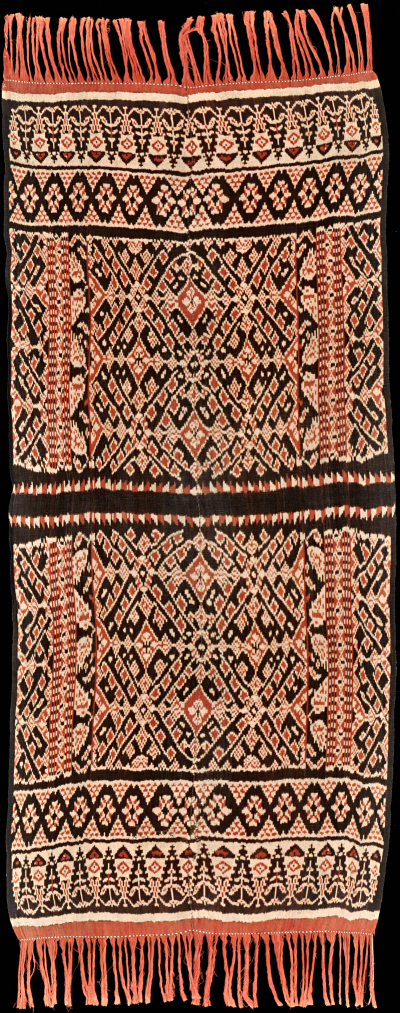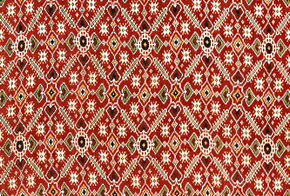| |
 
 | | | |
011 Roti Group, Roti
Lafa (shawl) 
| | Locale: | Termanu, most likely. | | Period: | 1925-1950 | | Yarn: | Cotton, commercial, fine, double-ply | | Technique: | Warp ikat | | Panels: | 2 | | Size: | 77 x 165 cm (2' 6" x 5' 4") LW: 2.14 | | Weight: | 375 g (13.2 oz), 295 g/m2 (0.97 oz/ft2) | | Design: | Lafa ketemak. A nobleman's cloth. At the center of both fields is the motif called dula penis, flanked by a pair of flowers known as the dula nggeo, or 'black motif', which is associated with Termanu. These identify the textile as a nobleman�s cloth. Elaborate tumpal borders. Executed in three tones: a very dark, almost black indigo (probably created by overdying with morinda) and morinda red on natural ecru background. Fox (1979:48): 'It should be noted that the dula penis is a Rotinese interpretation of patola motif. It takes as its 'center-point' what is, in effect, the intersection of two adjoining patola [jilamprang] motifs.' | | Comment: | Yarn is quite fine, and could also be toko yarn, but a few slight irregularities suggest manual manufacture. [No micro photography available yet.] Fairly tight weaving, though not as good as the best commoners' lafa. Colours slightly faded. Cloth shows signs of wear, old repair. | | Background: | Chapters on Roti Group and Roti. | | Published: | Woven Languages, 2014
Ikat Textiles of the Indonesian Archipelago, 2018. | | Compare: | 042 012 125 141 | | Sources: | Nearly identical to cloth depicted in Khan Majlis, Woven Messages, Fig. 240. Very similar to cloth dated 'before 1940' in Tropenmuseum, Nr. 1772-1159. See also Khan Majlis, Indonesische Textilien, Fig. 446. Very similar also to Boston Museum of Fine Arts, No. 27.468 and 27.469. Similar to 19th c. lafa in Yale University Art Gallery, 1951.51.77, but not quite as intricate. Also similar to Mattiebelle Gittinger, ed. Indonesian Textiles, James J. Fox's contribution, Fig. 1. Below, detail of patola in National Palace Museum, Taiwan, in style called Vohra Gaji Bhat.
 | | |

©Peter ten Hoopen, 2025
All rights reserved.
|
|


